Business Report: Evaluating Social Media's Role in Marketing and PR
VerifiedAdded on 2020/03/16
|11
|2438
|96
Report
AI Summary
This report provides a comprehensive analysis of social media's impact on business operations, encompassing public relations, marketing, and online business strategies. It begins with an introduction highlighting the integral role of social media in modern business and the need for tailored approaches. The report delves into the advantages of social media, such as enhanced communication, improved customer service, and cost-effective marketing, while also addressing the disadvantages, including the risk of negative publicity and the resources required for effective management. A detailed literature review explores various social media platforms like Facebook, Twitter, Instagram, and LinkedIn, discussing their specific applications and benefits. The report further outlines research questions and methodology, including qualitative and quantitative research approaches, along with limitations and a time schedule. The conclusion emphasizes the importance of strategic social media implementation for business success, acknowledging both the potential benefits and the risks involved, and urging businesses to plan and assess their social media marketing efforts carefully. The report also includes a comprehensive list of references.

Report
Student Name
Institute Name
Student Name
Institute Name
Paraphrase This Document
Need a fresh take? Get an instant paraphrase of this document with our AI Paraphraser
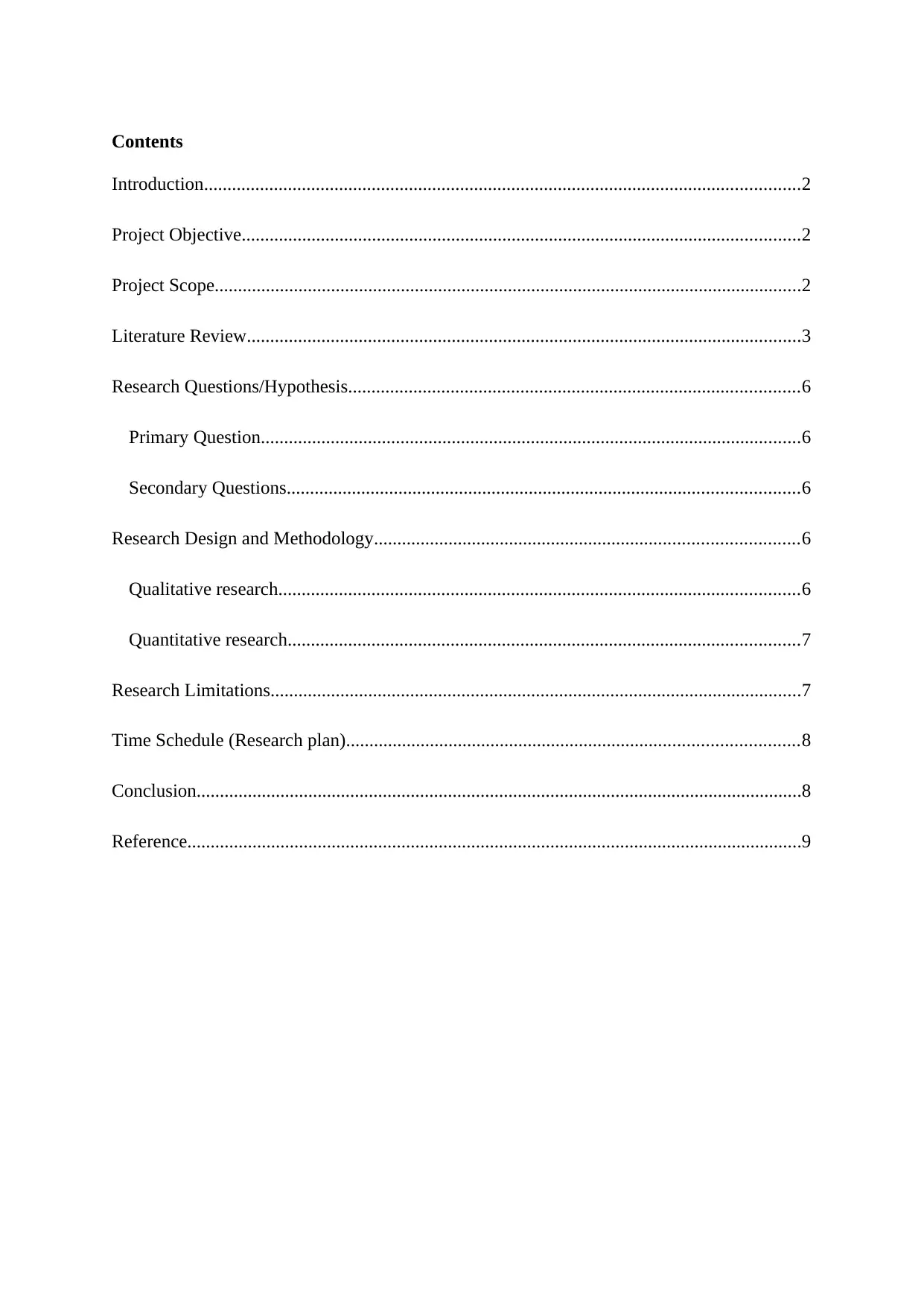
Contents
Introduction................................................................................................................................2
Project Objective........................................................................................................................2
Project Scope..............................................................................................................................2
Literature Review.......................................................................................................................3
Research Questions/Hypothesis.................................................................................................6
Primary Question....................................................................................................................6
Secondary Questions..............................................................................................................6
Research Design and Methodology...........................................................................................6
Qualitative research................................................................................................................6
Quantitative research..............................................................................................................7
Research Limitations..................................................................................................................7
Time Schedule (Research plan).................................................................................................8
Conclusion..................................................................................................................................8
Reference....................................................................................................................................9
Introduction................................................................................................................................2
Project Objective........................................................................................................................2
Project Scope..............................................................................................................................2
Literature Review.......................................................................................................................3
Research Questions/Hypothesis.................................................................................................6
Primary Question....................................................................................................................6
Secondary Questions..............................................................................................................6
Research Design and Methodology...........................................................................................6
Qualitative research................................................................................................................6
Quantitative research..............................................................................................................7
Research Limitations..................................................................................................................7
Time Schedule (Research plan).................................................................................................8
Conclusion..................................................................................................................................8
Reference....................................................................................................................................9

Introduction
Social media has become integral part of the business. Another thing which is crucial about
business is that when it comes to social networking in the organization, there cannot be one
rule which can fit all the organizations. The advantages of the social media in business
changes based on the characteristics and the company itself. Social media sites permit the
company to properly improve the process of communication and elevated level of
productivity by completely disseminating the data among separate set of groups of
workforces in a more effective way (Leonardi et al., 2013). It is further meant to be all
inclusive and the discussion in the report will help in outlining some of the advantages as
well as disadvantages of social media use at the organization.
Project Objective
The main objective of the report is to understand and evaluate the complete literature behind
the advantages as well as disadvantages of using social media for the business and cover
subjects like public relation, marketing and online business. The fact is that any kind of
innovation comes with certain pros and cons (Okazaki and Taylor, 2013). The main goal in
this report is to properly evaluate the impact of social media on the business activities and
how advantages can be utilised in the company.
Project Scope
The report will discuss in detail about the evaluation of detailed discussion based on
advantages and disadvantages of using social networking sites on number of many business
operations like public relations, marketing, sales and services, customer support and surveys
etc. The main discussion is based on commonly used social media platforms like twitter,
Facebook, Instagram and all these platforms are attached with daily or routine work in a
Social media has become integral part of the business. Another thing which is crucial about
business is that when it comes to social networking in the organization, there cannot be one
rule which can fit all the organizations. The advantages of the social media in business
changes based on the characteristics and the company itself. Social media sites permit the
company to properly improve the process of communication and elevated level of
productivity by completely disseminating the data among separate set of groups of
workforces in a more effective way (Leonardi et al., 2013). It is further meant to be all
inclusive and the discussion in the report will help in outlining some of the advantages as
well as disadvantages of social media use at the organization.
Project Objective
The main objective of the report is to understand and evaluate the complete literature behind
the advantages as well as disadvantages of using social media for the business and cover
subjects like public relation, marketing and online business. The fact is that any kind of
innovation comes with certain pros and cons (Okazaki and Taylor, 2013). The main goal in
this report is to properly evaluate the impact of social media on the business activities and
how advantages can be utilised in the company.
Project Scope
The report will discuss in detail about the evaluation of detailed discussion based on
advantages and disadvantages of using social networking sites on number of many business
operations like public relations, marketing, sales and services, customer support and surveys
etc. The main discussion is based on commonly used social media platforms like twitter,
Facebook, Instagram and all these platforms are attached with daily or routine work in a
⊘ This is a preview!⊘
Do you want full access?
Subscribe today to unlock all pages.

Trusted by 1+ million students worldwide
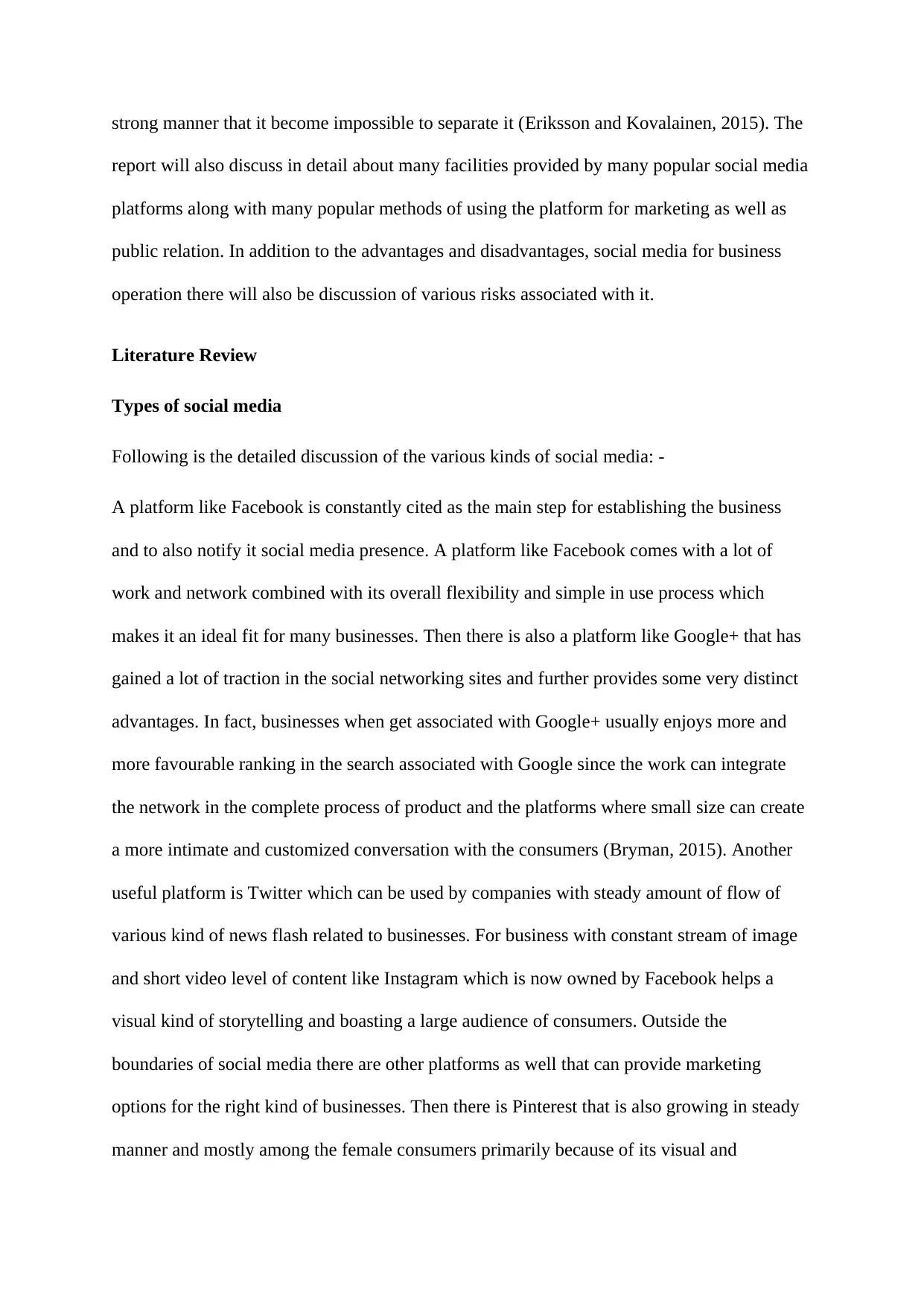
strong manner that it become impossible to separate it (Eriksson and Kovalainen, 2015). The
report will also discuss in detail about many facilities provided by many popular social media
platforms along with many popular methods of using the platform for marketing as well as
public relation. In addition to the advantages and disadvantages, social media for business
operation there will also be discussion of various risks associated with it.
Literature Review
Types of social media
Following is the detailed discussion of the various kinds of social media: -
A platform like Facebook is constantly cited as the main step for establishing the business
and to also notify it social media presence. A platform like Facebook comes with a lot of
work and network combined with its overall flexibility and simple in use process which
makes it an ideal fit for many businesses. Then there is also a platform like Google+ that has
gained a lot of traction in the social networking sites and further provides some very distinct
advantages. In fact, businesses when get associated with Google+ usually enjoys more and
more favourable ranking in the search associated with Google since the work can integrate
the network in the complete process of product and the platforms where small size can create
a more intimate and customized conversation with the consumers (Bryman, 2015). Another
useful platform is Twitter which can be used by companies with steady amount of flow of
various kind of news flash related to businesses. For business with constant stream of image
and short video level of content like Instagram which is now owned by Facebook helps a
visual kind of storytelling and boasting a large audience of consumers. Outside the
boundaries of social media there are other platforms as well that can provide marketing
options for the right kind of businesses. Then there is Pinterest that is also growing in steady
manner and mostly among the female consumers primarily because of its visual and
report will also discuss in detail about many facilities provided by many popular social media
platforms along with many popular methods of using the platform for marketing as well as
public relation. In addition to the advantages and disadvantages, social media for business
operation there will also be discussion of various risks associated with it.
Literature Review
Types of social media
Following is the detailed discussion of the various kinds of social media: -
A platform like Facebook is constantly cited as the main step for establishing the business
and to also notify it social media presence. A platform like Facebook comes with a lot of
work and network combined with its overall flexibility and simple in use process which
makes it an ideal fit for many businesses. Then there is also a platform like Google+ that has
gained a lot of traction in the social networking sites and further provides some very distinct
advantages. In fact, businesses when get associated with Google+ usually enjoys more and
more favourable ranking in the search associated with Google since the work can integrate
the network in the complete process of product and the platforms where small size can create
a more intimate and customized conversation with the consumers (Bryman, 2015). Another
useful platform is Twitter which can be used by companies with steady amount of flow of
various kind of news flash related to businesses. For business with constant stream of image
and short video level of content like Instagram which is now owned by Facebook helps a
visual kind of storytelling and boasting a large audience of consumers. Outside the
boundaries of social media there are other platforms as well that can provide marketing
options for the right kind of businesses. Then there is Pinterest that is also growing in steady
manner and mostly among the female consumers primarily because of its visual and
Paraphrase This Document
Need a fresh take? Get an instant paraphrase of this document with our AI Paraphraser
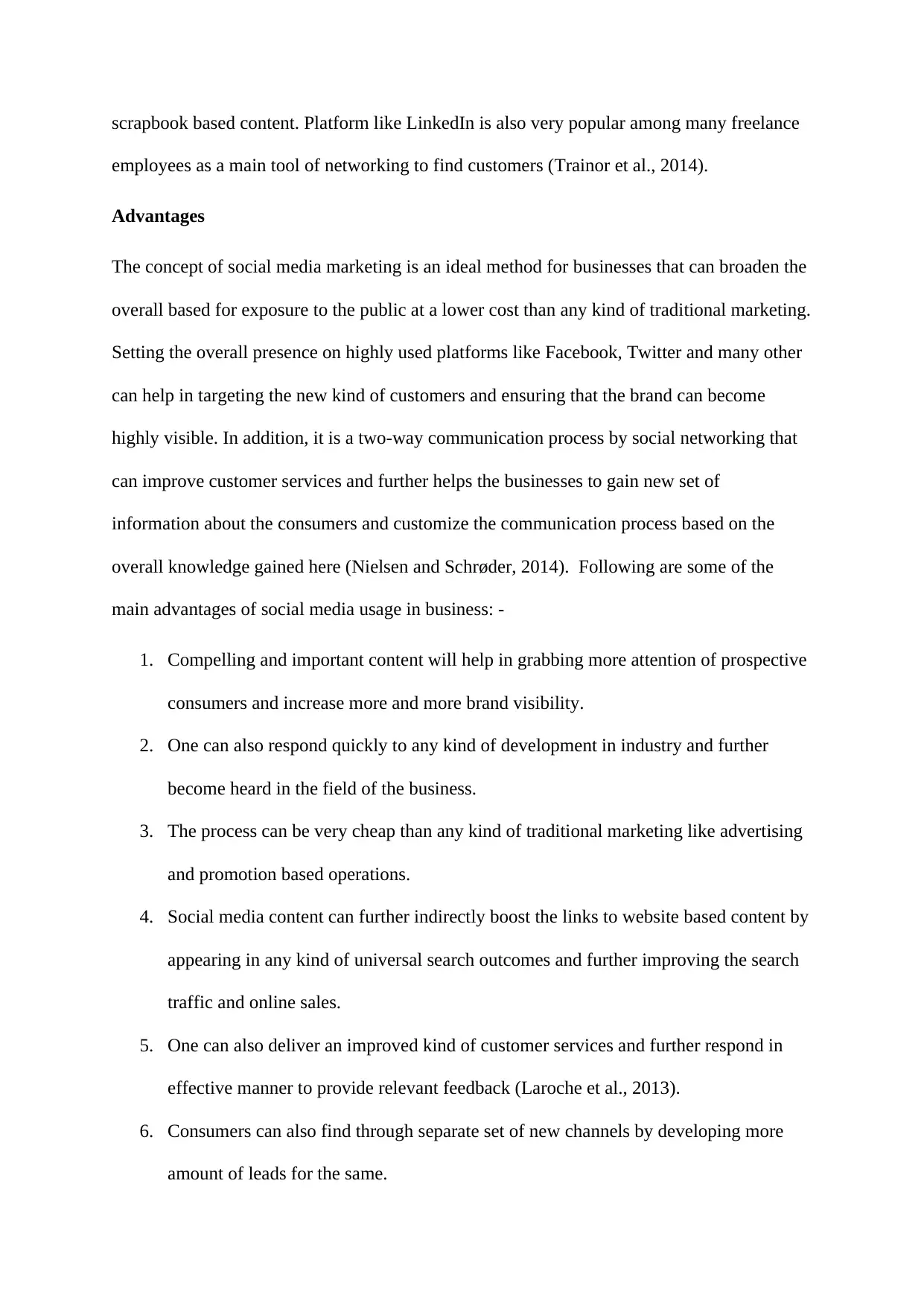
scrapbook based content. Platform like LinkedIn is also very popular among many freelance
employees as a main tool of networking to find customers (Trainor et al., 2014).
Advantages
The concept of social media marketing is an ideal method for businesses that can broaden the
overall based for exposure to the public at a lower cost than any kind of traditional marketing.
Setting the overall presence on highly used platforms like Facebook, Twitter and many other
can help in targeting the new kind of customers and ensuring that the brand can become
highly visible. In addition, it is a two-way communication process by social networking that
can improve customer services and further helps the businesses to gain new set of
information about the consumers and customize the communication process based on the
overall knowledge gained here (Nielsen and Schrøder, 2014). Following are some of the
main advantages of social media usage in business: -
1. Compelling and important content will help in grabbing more attention of prospective
consumers and increase more and more brand visibility.
2. One can also respond quickly to any kind of development in industry and further
become heard in the field of the business.
3. The process can be very cheap than any kind of traditional marketing like advertising
and promotion based operations.
4. Social media content can further indirectly boost the links to website based content by
appearing in any kind of universal search outcomes and further improving the search
traffic and online sales.
5. One can also deliver an improved kind of customer services and further respond in
effective manner to provide relevant feedback (Laroche et al., 2013).
6. Consumers can also find through separate set of new channels by developing more
amount of leads for the same.
employees as a main tool of networking to find customers (Trainor et al., 2014).
Advantages
The concept of social media marketing is an ideal method for businesses that can broaden the
overall based for exposure to the public at a lower cost than any kind of traditional marketing.
Setting the overall presence on highly used platforms like Facebook, Twitter and many other
can help in targeting the new kind of customers and ensuring that the brand can become
highly visible. In addition, it is a two-way communication process by social networking that
can improve customer services and further helps the businesses to gain new set of
information about the consumers and customize the communication process based on the
overall knowledge gained here (Nielsen and Schrøder, 2014). Following are some of the
main advantages of social media usage in business: -
1. Compelling and important content will help in grabbing more attention of prospective
consumers and increase more and more brand visibility.
2. One can also respond quickly to any kind of development in industry and further
become heard in the field of the business.
3. The process can be very cheap than any kind of traditional marketing like advertising
and promotion based operations.
4. Social media content can further indirectly boost the links to website based content by
appearing in any kind of universal search outcomes and further improving the search
traffic and online sales.
5. One can also deliver an improved kind of customer services and further respond in
effective manner to provide relevant feedback (Laroche et al., 2013).
6. Consumers can also find through separate set of new channels by developing more
amount of leads for the same.
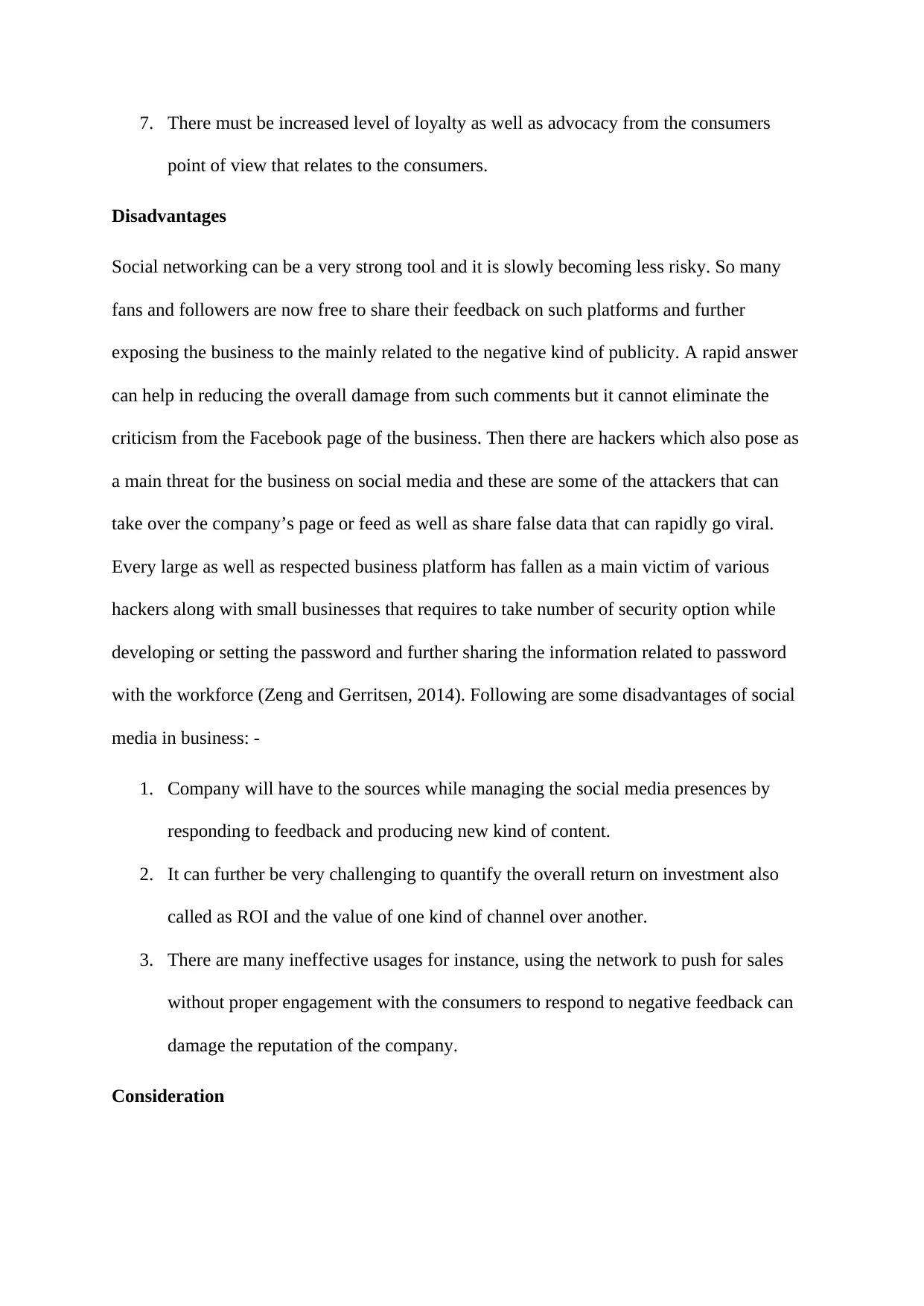
7. There must be increased level of loyalty as well as advocacy from the consumers
point of view that relates to the consumers.
Disadvantages
Social networking can be a very strong tool and it is slowly becoming less risky. So many
fans and followers are now free to share their feedback on such platforms and further
exposing the business to the mainly related to the negative kind of publicity. A rapid answer
can help in reducing the overall damage from such comments but it cannot eliminate the
criticism from the Facebook page of the business. Then there are hackers which also pose as
a main threat for the business on social media and these are some of the attackers that can
take over the company’s page or feed as well as share false data that can rapidly go viral.
Every large as well as respected business platform has fallen as a main victim of various
hackers along with small businesses that requires to take number of security option while
developing or setting the password and further sharing the information related to password
with the workforce (Zeng and Gerritsen, 2014). Following are some disadvantages of social
media in business: -
1. Company will have to the sources while managing the social media presences by
responding to feedback and producing new kind of content.
2. It can further be very challenging to quantify the overall return on investment also
called as ROI and the value of one kind of channel over another.
3. There are many ineffective usages for instance, using the network to push for sales
without proper engagement with the consumers to respond to negative feedback can
damage the reputation of the company.
Consideration
point of view that relates to the consumers.
Disadvantages
Social networking can be a very strong tool and it is slowly becoming less risky. So many
fans and followers are now free to share their feedback on such platforms and further
exposing the business to the mainly related to the negative kind of publicity. A rapid answer
can help in reducing the overall damage from such comments but it cannot eliminate the
criticism from the Facebook page of the business. Then there are hackers which also pose as
a main threat for the business on social media and these are some of the attackers that can
take over the company’s page or feed as well as share false data that can rapidly go viral.
Every large as well as respected business platform has fallen as a main victim of various
hackers along with small businesses that requires to take number of security option while
developing or setting the password and further sharing the information related to password
with the workforce (Zeng and Gerritsen, 2014). Following are some disadvantages of social
media in business: -
1. Company will have to the sources while managing the social media presences by
responding to feedback and producing new kind of content.
2. It can further be very challenging to quantify the overall return on investment also
called as ROI and the value of one kind of channel over another.
3. There are many ineffective usages for instance, using the network to push for sales
without proper engagement with the consumers to respond to negative feedback can
damage the reputation of the company.
Consideration
⊘ This is a preview!⊘
Do you want full access?
Subscribe today to unlock all pages.

Trusted by 1+ million students worldwide
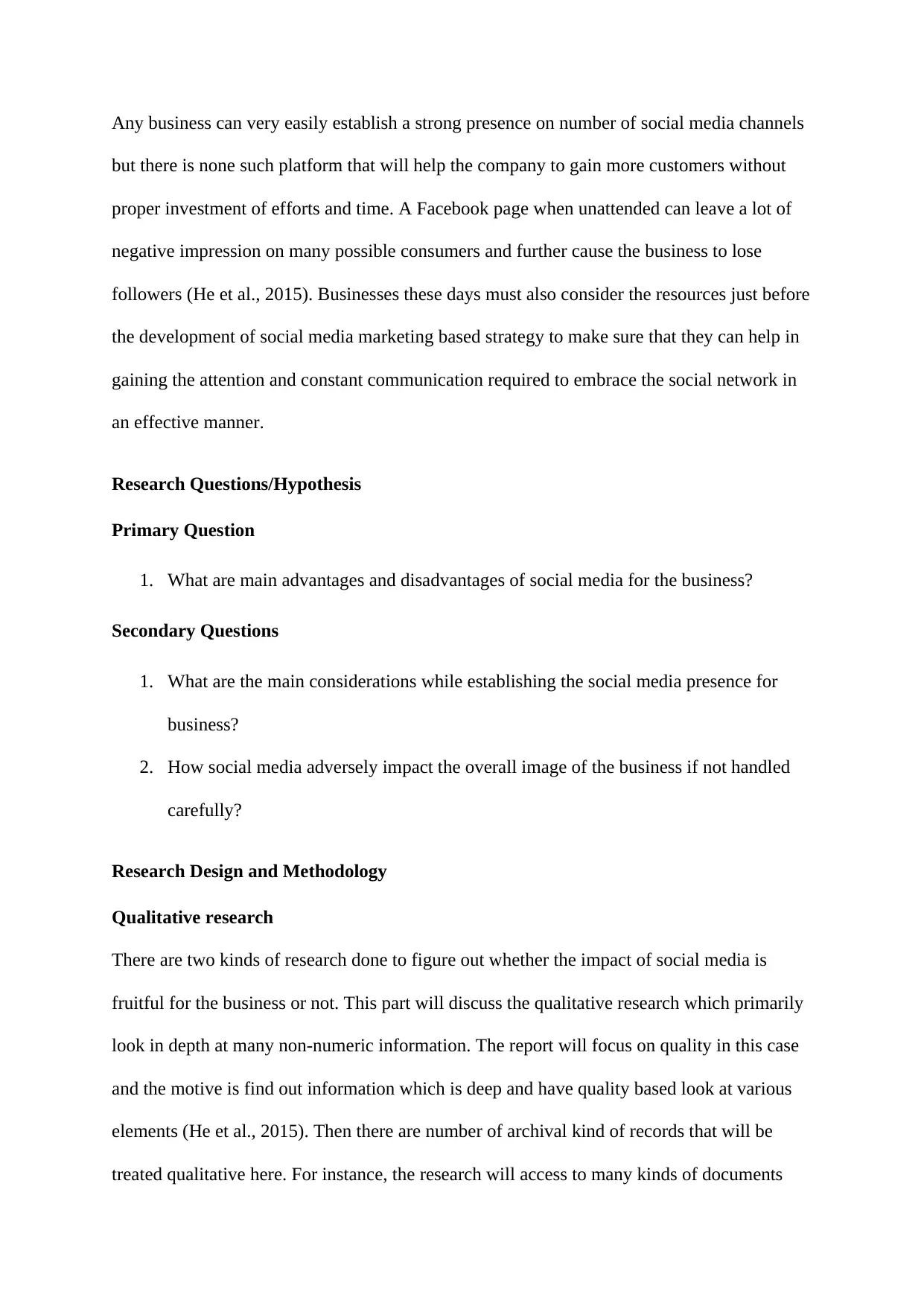
Any business can very easily establish a strong presence on number of social media channels
but there is none such platform that will help the company to gain more customers without
proper investment of efforts and time. A Facebook page when unattended can leave a lot of
negative impression on many possible consumers and further cause the business to lose
followers (He et al., 2015). Businesses these days must also consider the resources just before
the development of social media marketing based strategy to make sure that they can help in
gaining the attention and constant communication required to embrace the social network in
an effective manner.
Research Questions/Hypothesis
Primary Question
1. What are main advantages and disadvantages of social media for the business?
Secondary Questions
1. What are the main considerations while establishing the social media presence for
business?
2. How social media adversely impact the overall image of the business if not handled
carefully?
Research Design and Methodology
Qualitative research
There are two kinds of research done to figure out whether the impact of social media is
fruitful for the business or not. This part will discuss the qualitative research which primarily
look in depth at many non-numeric information. The report will focus on quality in this case
and the motive is find out information which is deep and have quality based look at various
elements (He et al., 2015). Then there are number of archival kind of records that will be
treated qualitative here. For instance, the research will access to many kinds of documents
but there is none such platform that will help the company to gain more customers without
proper investment of efforts and time. A Facebook page when unattended can leave a lot of
negative impression on many possible consumers and further cause the business to lose
followers (He et al., 2015). Businesses these days must also consider the resources just before
the development of social media marketing based strategy to make sure that they can help in
gaining the attention and constant communication required to embrace the social network in
an effective manner.
Research Questions/Hypothesis
Primary Question
1. What are main advantages and disadvantages of social media for the business?
Secondary Questions
1. What are the main considerations while establishing the social media presence for
business?
2. How social media adversely impact the overall image of the business if not handled
carefully?
Research Design and Methodology
Qualitative research
There are two kinds of research done to figure out whether the impact of social media is
fruitful for the business or not. This part will discuss the qualitative research which primarily
look in depth at many non-numeric information. The report will focus on quality in this case
and the motive is find out information which is deep and have quality based look at various
elements (He et al., 2015). Then there are number of archival kind of records that will be
treated qualitative here. For instance, the research will access to many kinds of documents
Paraphrase This Document
Need a fresh take? Get an instant paraphrase of this document with our AI Paraphraser
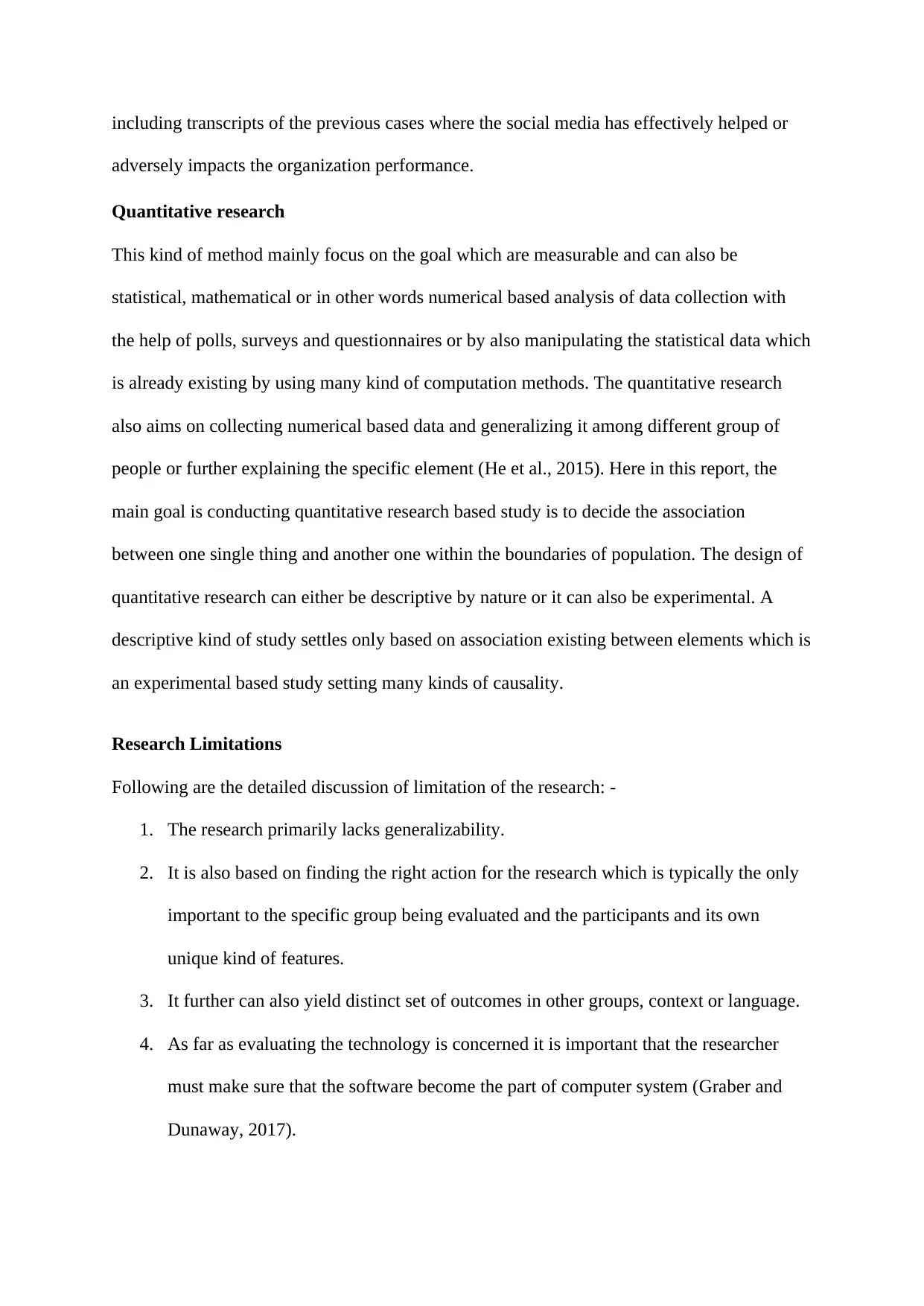
including transcripts of the previous cases where the social media has effectively helped or
adversely impacts the organization performance.
Quantitative research
This kind of method mainly focus on the goal which are measurable and can also be
statistical, mathematical or in other words numerical based analysis of data collection with
the help of polls, surveys and questionnaires or by also manipulating the statistical data which
is already existing by using many kind of computation methods. The quantitative research
also aims on collecting numerical based data and generalizing it among different group of
people or further explaining the specific element (He et al., 2015). Here in this report, the
main goal is conducting quantitative research based study is to decide the association
between one single thing and another one within the boundaries of population. The design of
quantitative research can either be descriptive by nature or it can also be experimental. A
descriptive kind of study settles only based on association existing between elements which is
an experimental based study setting many kinds of causality.
Research Limitations
Following are the detailed discussion of limitation of the research: -
1. The research primarily lacks generalizability.
2. It is also based on finding the right action for the research which is typically the only
important to the specific group being evaluated and the participants and its own
unique kind of features.
3. It further can also yield distinct set of outcomes in other groups, context or language.
4. As far as evaluating the technology is concerned it is important that the researcher
must make sure that the software become the part of computer system (Graber and
Dunaway, 2017).
adversely impacts the organization performance.
Quantitative research
This kind of method mainly focus on the goal which are measurable and can also be
statistical, mathematical or in other words numerical based analysis of data collection with
the help of polls, surveys and questionnaires or by also manipulating the statistical data which
is already existing by using many kind of computation methods. The quantitative research
also aims on collecting numerical based data and generalizing it among different group of
people or further explaining the specific element (He et al., 2015). Here in this report, the
main goal is conducting quantitative research based study is to decide the association
between one single thing and another one within the boundaries of population. The design of
quantitative research can either be descriptive by nature or it can also be experimental. A
descriptive kind of study settles only based on association existing between elements which is
an experimental based study setting many kinds of causality.
Research Limitations
Following are the detailed discussion of limitation of the research: -
1. The research primarily lacks generalizability.
2. It is also based on finding the right action for the research which is typically the only
important to the specific group being evaluated and the participants and its own
unique kind of features.
3. It further can also yield distinct set of outcomes in other groups, context or language.
4. As far as evaluating the technology is concerned it is important that the researcher
must make sure that the software become the part of computer system (Graber and
Dunaway, 2017).
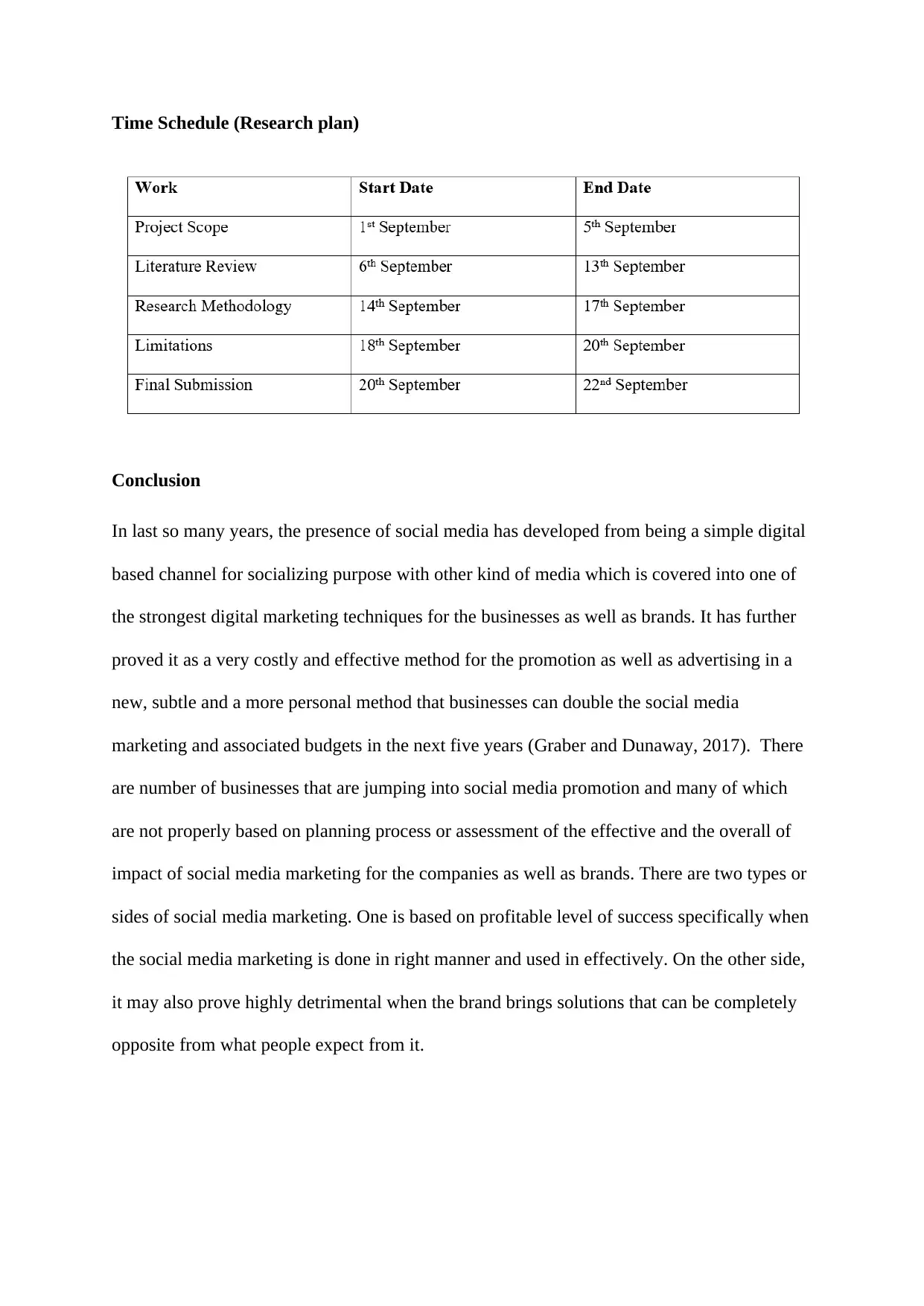
Time Schedule (Research plan)
Conclusion
In last so many years, the presence of social media has developed from being a simple digital
based channel for socializing purpose with other kind of media which is covered into one of
the strongest digital marketing techniques for the businesses as well as brands. It has further
proved it as a very costly and effective method for the promotion as well as advertising in a
new, subtle and a more personal method that businesses can double the social media
marketing and associated budgets in the next five years (Graber and Dunaway, 2017). There
are number of businesses that are jumping into social media promotion and many of which
are not properly based on planning process or assessment of the effective and the overall of
impact of social media marketing for the companies as well as brands. There are two types or
sides of social media marketing. One is based on profitable level of success specifically when
the social media marketing is done in right manner and used in effectively. On the other side,
it may also prove highly detrimental when the brand brings solutions that can be completely
opposite from what people expect from it.
Conclusion
In last so many years, the presence of social media has developed from being a simple digital
based channel for socializing purpose with other kind of media which is covered into one of
the strongest digital marketing techniques for the businesses as well as brands. It has further
proved it as a very costly and effective method for the promotion as well as advertising in a
new, subtle and a more personal method that businesses can double the social media
marketing and associated budgets in the next five years (Graber and Dunaway, 2017). There
are number of businesses that are jumping into social media promotion and many of which
are not properly based on planning process or assessment of the effective and the overall of
impact of social media marketing for the companies as well as brands. There are two types or
sides of social media marketing. One is based on profitable level of success specifically when
the social media marketing is done in right manner and used in effectively. On the other side,
it may also prove highly detrimental when the brand brings solutions that can be completely
opposite from what people expect from it.
⊘ This is a preview!⊘
Do you want full access?
Subscribe today to unlock all pages.

Trusted by 1+ million students worldwide
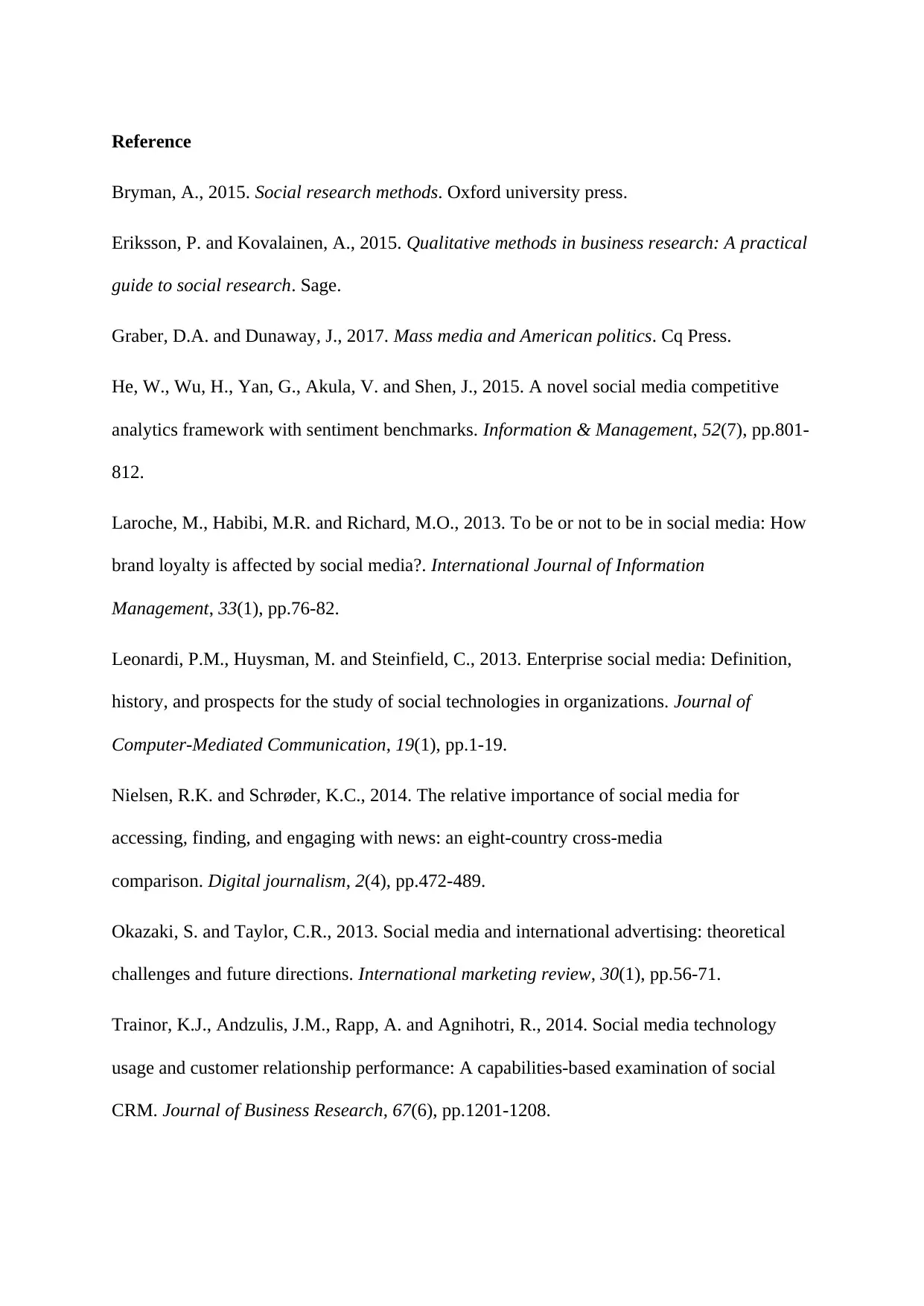
Reference
Bryman, A., 2015. Social research methods. Oxford university press.
Eriksson, P. and Kovalainen, A., 2015. Qualitative methods in business research: A practical
guide to social research. Sage.
Graber, D.A. and Dunaway, J., 2017. Mass media and American politics. Cq Press.
He, W., Wu, H., Yan, G., Akula, V. and Shen, J., 2015. A novel social media competitive
analytics framework with sentiment benchmarks. Information & Management, 52(7), pp.801-
812.
Laroche, M., Habibi, M.R. and Richard, M.O., 2013. To be or not to be in social media: How
brand loyalty is affected by social media?. International Journal of Information
Management, 33(1), pp.76-82.
Leonardi, P.M., Huysman, M. and Steinfield, C., 2013. Enterprise social media: Definition,
history, and prospects for the study of social technologies in organizations. Journal of
Computer‐Mediated Communication, 19(1), pp.1-19.
Nielsen, R.K. and Schrøder, K.C., 2014. The relative importance of social media for
accessing, finding, and engaging with news: an eight-country cross-media
comparison. Digital journalism, 2(4), pp.472-489.
Okazaki, S. and Taylor, C.R., 2013. Social media and international advertising: theoretical
challenges and future directions. International marketing review, 30(1), pp.56-71.
Trainor, K.J., Andzulis, J.M., Rapp, A. and Agnihotri, R., 2014. Social media technology
usage and customer relationship performance: A capabilities-based examination of social
CRM. Journal of Business Research, 67(6), pp.1201-1208.
Bryman, A., 2015. Social research methods. Oxford university press.
Eriksson, P. and Kovalainen, A., 2015. Qualitative methods in business research: A practical
guide to social research. Sage.
Graber, D.A. and Dunaway, J., 2017. Mass media and American politics. Cq Press.
He, W., Wu, H., Yan, G., Akula, V. and Shen, J., 2015. A novel social media competitive
analytics framework with sentiment benchmarks. Information & Management, 52(7), pp.801-
812.
Laroche, M., Habibi, M.R. and Richard, M.O., 2013. To be or not to be in social media: How
brand loyalty is affected by social media?. International Journal of Information
Management, 33(1), pp.76-82.
Leonardi, P.M., Huysman, M. and Steinfield, C., 2013. Enterprise social media: Definition,
history, and prospects for the study of social technologies in organizations. Journal of
Computer‐Mediated Communication, 19(1), pp.1-19.
Nielsen, R.K. and Schrøder, K.C., 2014. The relative importance of social media for
accessing, finding, and engaging with news: an eight-country cross-media
comparison. Digital journalism, 2(4), pp.472-489.
Okazaki, S. and Taylor, C.R., 2013. Social media and international advertising: theoretical
challenges and future directions. International marketing review, 30(1), pp.56-71.
Trainor, K.J., Andzulis, J.M., Rapp, A. and Agnihotri, R., 2014. Social media technology
usage and customer relationship performance: A capabilities-based examination of social
CRM. Journal of Business Research, 67(6), pp.1201-1208.
Paraphrase This Document
Need a fresh take? Get an instant paraphrase of this document with our AI Paraphraser

Zeng, B. and Gerritsen, R., 2014. What do we know about social media in tourism? A
review. Tourism Management Perspectives, 10, pp.27-36.
review. Tourism Management Perspectives, 10, pp.27-36.
1 out of 11
Related Documents
Your All-in-One AI-Powered Toolkit for Academic Success.
+13062052269
info@desklib.com
Available 24*7 on WhatsApp / Email
![[object Object]](/_next/static/media/star-bottom.7253800d.svg)
Unlock your academic potential
Copyright © 2020–2025 A2Z Services. All Rights Reserved. Developed and managed by ZUCOL.




